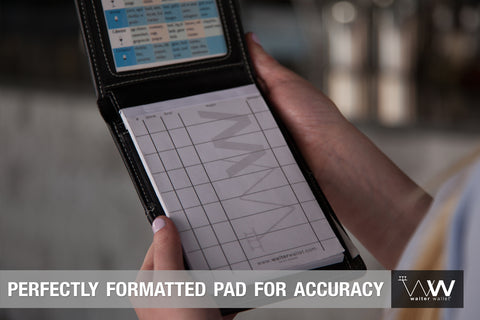Taking a guest's order seems very straightforward. However, here are some common mistakes restaurants and their servers make all too often.
Number one, don’t memorize guests orders no matter how amazing your memory is. I guarantee you, every time a sever memorizes an order, as soon as they leave the table, the guests will discuss how their order will be incorrect. Whether you get it right or not, the damage has been done. You have adversely impacted the guests dining experience by shifting their conversation to you and your memory.
Number two; use a properly formatted restaurant pad, like the Waiter Wallet Pads. Believe it or not, having specific areas to write drinks, apps, entrees and deserts result in less scribbling and fewer mistakes. This is exactly why large, number crunching, chain restaurants provide free pads to their servers.
Number three; use a professional waiter or waitress organizer book. Using a check presenter is not only dysfunctional but it exposes all of a server’s business to guests and looks sloppy. By contrast, a Waiter Wallet not only looks professional but it also hides its contents from guest’s eyes while discretely displaying moneymaking information at server’s fingertips.
Number four: Before approaching the table, write down the table number and the position numbers of each guest. Then, when taking the order, start with the lady at the lowest position number and proceed to the female guest at the next position number. Once all the ladies orders have been taken go back around the table, in the same direction, and take the men’s orders. Of course, if a guest or guests have other preferences, accommodate those preferences and then, if appropriate, return to the ladies first method.
Lastly, eight-six tableside POS systems. This is often out of a server’s control but the use of these devices should be reconsidered. Why? First, how much time is really being saved? Consider this. A server must either lug these devices around the restaurant all shift or retrieve them from a service station. Either way, it is incredibly inefficient and expensive. Also, these devices are significantly smaller and thereby slower to use than a stationary POS system. But more significantly, the use of these tableside devices significantly imposes upon the guest experience with this considerably slower, all-consuming process. After all, when writing down an order, servers can typically write as fast as the guest speaks and they remain engaged with the guest during the process. By contrast, when entering the order into a tableside POS, the server, obsessed with not making a mistake, is locked into their device and not the guest.
Hopefully, these suggestions help waiters, waitress and restaurants better focus on the guest and take more accurate and less problematic food and drink orders.




